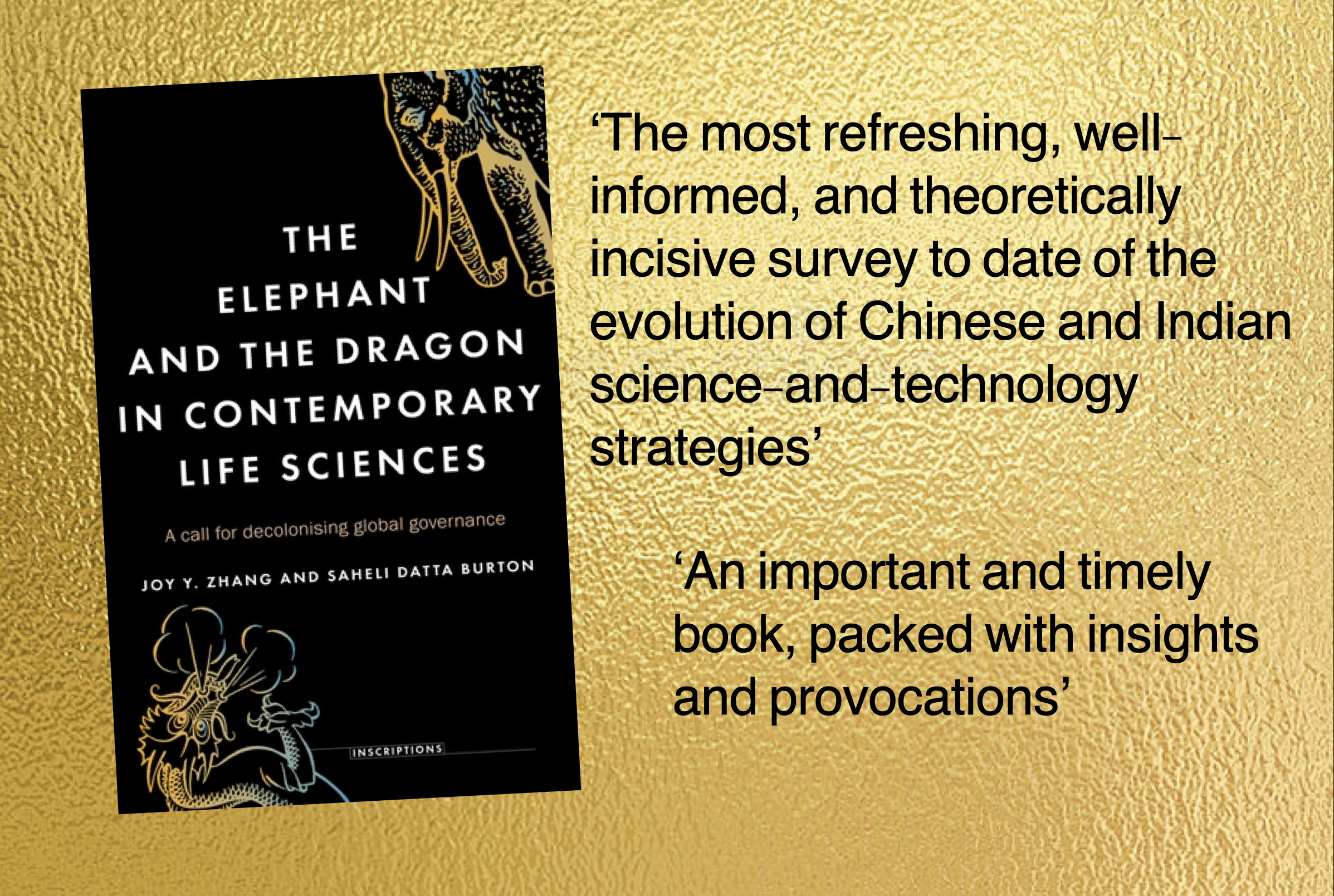We’re pleased to announce the publication of Dr Joy Y. Zhang and Dr Saheli Datta Burton’s new book, The Elephant and the Dragon of the Contemporary Life Sciences: A Call for Decolonising Global Governance.
In the life sciences, China and India are both seen as emerging ‘dragons’ and as ‘elephants’. Both countries have formidable resources and are boldly determined to have their presence felt. Yet even when regulatory pledges are made between Western institutions and China or India during international meetings, there often remains an ‘elephant in the room’. Would these two Global South scientific ‘dragons’ really abide by the agreed rules? The apparent yet unsettling issue is that the two emerging powers seem to be ‘epistemically disobedient’. Yet the ‘subversiveness’ China and India present and represent mirror a wider phenomenon in which previously marginalised actors, both from the Global South and Global North, contest the conventional thinking of how science and scientists should be governed.
The book opens with unpacking the 2018 CRISPR baby scandal and its global impacts. Jiankui He’s experiment was a perfect example which exposed the multi-layered ambiguities and contradictions in the realpolitik of the Global South’s drive for influence in frontier research and how power struggles are enmeshed with subaltern anxieties. More importantly, it illuminates why some of the ‘deviance’ manifested by China and India are not country-specific, but underlie shared challenges brought on by a growing diversity of ways of doing research outside of conventional institutions. This scandal also highlight the three key trajectories of contemporary science, namely bottom-up brokerage, de-territoriality of science and cosmopolitanised civic epistemology, which necessitate us to de-colonise our approach to governance. By the word ‘decolonise’, this book not only refers to the existing epistemic project of decolonial theorisation but also stresses a more fundamental meaning of being able to think outside of scientific ‘colonies’. That is, established social space and interactive order that govern a group of individuals with similar interests or are committed to a certain type of behaviour.
Through engaging analysis of the ‘national habitus’ of China’s and India’s life science, the book enable readers to ‘think from and with’ global others. For China, the book points out that various conflicts and contradictions in its global rise in the life sciences are best understood as a ‘struggle for recognition’ both domestically and globally. Closer inspection on critical events such as China’s joining of the Human Genome Project, hybrid embryo research, the Golden Rice controversy and the COVID pandemic debunks the erroneous impression that researchers in China are passive ‘state scientists’. Rather, even in an authoritarian country, the national habitus of science is constantly challenged and reshaped by bottom-up initiative from scientists, bioethicists, and the general public. Meanwhile the Indian experience highlights that conventional ways of designing and delivering regulations can easily be trapped in a self-referential ‘bureaucratic amplification of credibility’ which has limited ability to speak, let alone respond to diverse risk preferences. Central to many of the global controversies we’ve witnessed in the life sciences in recent decades is the question ‘who could do science’. For governance to be effective, it has to stay relevant to the subject it aims to govern.
Those who are not focused on science governance per se may nevertheless find the book illuminating. The book sheds lights on a classic a Gordian knot that has been plaguing many international relation issues: Western observers argue Chinese and Indian scientific communities need to prove themselves as trusted players first and then they would naturally win respect, while Chinese and Indian stakeholders argue that the West needs to acquire a fair attitude first and then they would naturally see the value and ingenuities of the Global South in contemporary science. The book unties this Gordian knot by elucidating how China and India position themselves in the twin process of modernisation and globalisation, how it gives rise to a particular subaltern anxiety and how it can be overcome. The book’s elucidation of ‘leftist science populism’ and its latent effect of the two countries’ global expansion also helps to contextualise the political logic of their vaccine diplomacy.
What may a de-colonised global governance look like? The book ends with an invitation to ponder the question ‘what global science will have been’? This future anterior framing was first proposed by the feminist scholar Tani Barlow. This linguistic construct draws attention to the fact that the anticipated future is embedded in the present (or that a present scenario was embedded in the past). More than anytime in world history, the sciences, especially the life sciences, are shaped by the confluence of private pursuits, national ambition and transnational assemblages. The book ends with provocative reflections on how should re-think about ‘time’, ‘place’ and ‘people’ in contemporary life sciences.
To quote the book’s concluding paragraph, ‘Science has long ceased to be a globalised venture in the sense of having a monolithic view and uniform practices. But science remains universal, not so much in its practice or norms, but as a universal symbol of hope and a reminder of our interconnectedness, both in the present and in our common future. Perhaps it is high time that we consult each other’s views on “what global science will have been”. After all, it is not the conclusions reached but the questions we ask that make us who we are.’
Find out more and read about the reviews, please go to the publisher’s page: https://manchesteruniversitypress.co.uk/9781526159526/

